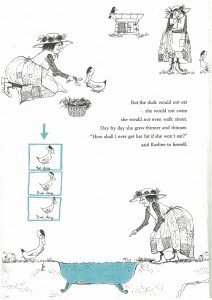Karline’s Duck is the only book I’ve brought with me from my childhood. This is not to suggest I had other books. In fact, I’m pretty sure this is the only book I owned. And…I didn’t really own it, I stole it from the Winnipeg Public Library, St James Branch, Boys and Girls Department. However, as I was not yet seven when my family moved from Winnipeg to Edmonton in 1970, I think it’s fair to suggest my parents stole it. I don’t know which one, probably my mother. She could be shifty. Or maybe I just tucked it away somewhere and it got packed along with my Barrel of Monkeys and my dear yellow blankie. When you’re moving a family of seven across western Canada in the five-seater Buick, contraband is the least of your worries. The fact remains that Karline’s Duck, so loved, so tattered, was not my book then, but it is my book now. It’s a matter of squatter’s rights. Karline’s Duck has squatted (so to speak) on my shelves for almost 40 years. I haven’t the heart to send her home now.
I know Karline’s Duck better than any other book I own. Indeed, I know it better than the back of my hand, which is continually morphing into something unrecognizable. The illustrations are simple, detailed line drawings, depicting Karline, her duck, and the grubby little town where she works her trade as a rag and bone woman. In her patchwork skirt, Karline pushes her pram through the streets, collecting the town’s rubbish, selling it to the rag and bone merchant and one can only assume, leading a miserable, lonely life. (Yes, you are correct, this is German book). Things take a turn for the worse when the town decides to hire actual garbage men, ousting poor Karline from her only source of income. Her neighbour takes pity on her and gives her a duck, a lame and thin duck, but he assures her that with a little TLC, the duck will make an excellent roast dinner.
Of course, this is not how children’s books end, not even German children’s books.
Karline builds a hutch for her duck, and sinks an old bathtub in the ground so that the duck can swim. (Note: I asked my mother to ‘sink’ a tub for our dog, but she was not nearly as kind or resourceful as Karline.) Soon, the duck is being wheeled around town in Karline’s pram and after some attention from the town vet, the duck rallies, and the two become friends. Eventually Karline’s duck begins laying eggs, and a new source of income is born. They open a tea and egg shop, and the last scene shows Karline relaxing under a tree, smoking a fag with her beloved duck.
Karline’s Duck was written in 1961 by Tilde Michels, a German children’s author and translator. Although she is the author of many books, I was only able to find a small biographical paragraph about her online, in German. The illustrations are by Lilo Fromm, who apparently has more than 255 published works, but like Michels, Fromm is virtually unknown outside of Europe, and only a few books have been translated into English. Karline’s Duck is long out of print, but I did find a few cover shots. Unfortunately, the beautiful black, white and blue cover was replaced by a more garish illustration. Funny how our simple tastes erode over time.
The story and especially the illustrations are entirely original and charming, but unglamourized in a way you just don’t see in kids books anymore. The townsfolk are brutish, and Karline is just this side of a dried apple-faced witch. The duck is sporting what appears to be a black tumour or beret on her head, which I assume is a scribbled representation of a physical characteristic of that particular breed of duck. Michels and Fromm did not strain their creative muscles to make the story or the illustrations cute. Honest, yes. Quirky, definitely. But cute? Not at all. The drawings in Karline’s Duck do not inspire awe, but they do engage the reader, and they tell the story in wonderful, idiosyncratic detail. I love that weird duck, and I love ugly Karline, and all of the unloveable, loveable characters and illustrations in the book. Every house, every bit of garbage in Karline’s pram, every stage of the duck’s recovery is imprinted on my brain, and even if it hadn’t been in my criminal possession all these years, Karline’s Duck would have stayed tucked in my neural passageways. Michels and Fromm clearly trusted their audience, just like the Winnipeg Public Library trusted their patrons. Smart author, smart illustrator. Foolish library.
Karline’s Duck, written by Tilde Michels and illustrated by Lilo Fromm
Oxford University Press, 1961





I loved this book as a kid! It was one of my favorites 🙂 If you would ever consider passing it along I would love to re-read it.